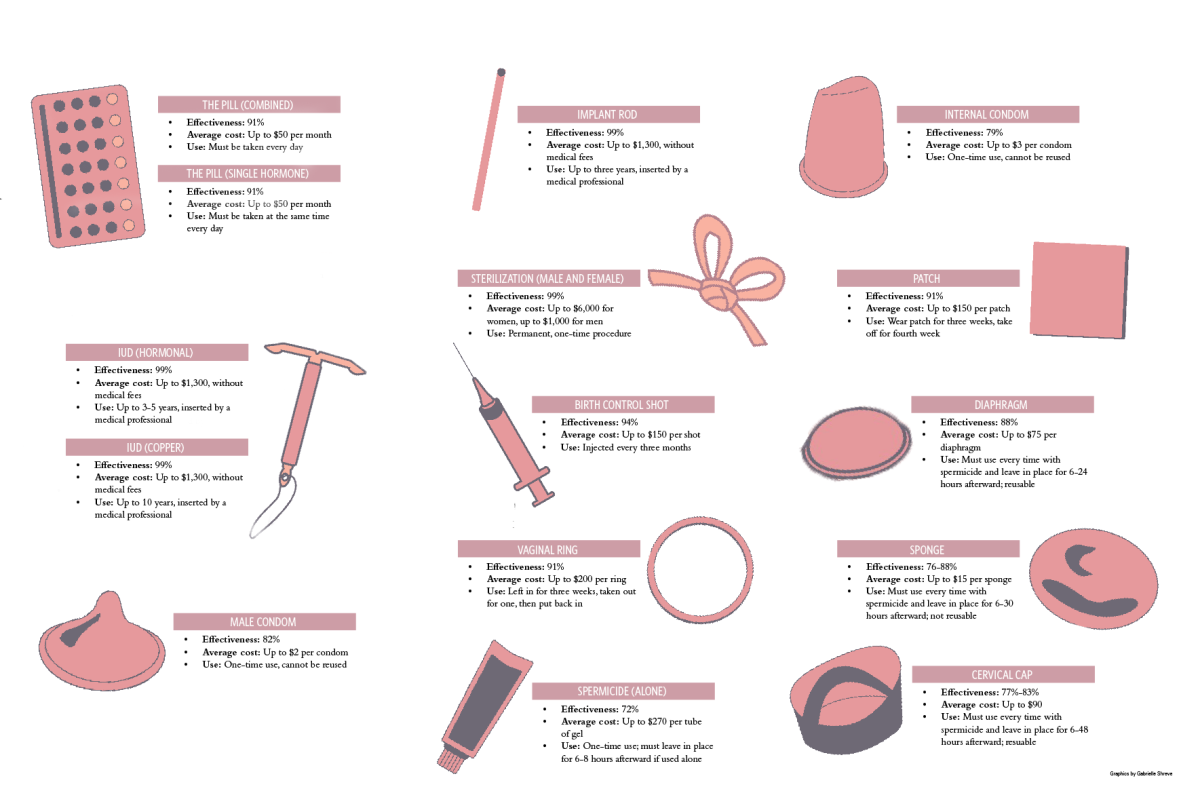From temporary to permanent, there are an overwhelming amount of contraceptives available on the market.
Most known for lowering the possibility of pregnancy, contraceptives can have a variety of benefits for people, including managing periods and acne as well as preventing sexually transmitted diseases, or STIs. Dr. Sophia Yen, founder and CEO of the women- and doctor-led Pandia Health birth control delivery company, said 70 percent of people on birth control are using it for reasons other than pregnancy prevention.
As far as the best method to choose, Yen said it depends on the person.
“What’s the best birth control out there? … The IUD or implant,” Yen said. “But for some people, they’re not willing or ready to have something put in their uterus, or not ready to have something put in their arm.”
Among other options available for people with uteruses are the patch, the ring, the shot and the pill, which has 40 different types available with varying amounts of progesterone and estrogen. Yen said it is not healthy for anyone under the age of 30 to take birth control pills with less than 30 micrograms of estrogen, as this can be damaging to one’s bone density in the long run.
Figuring out which pill, or other contraceptive method, that will be best for your body is dependent upon the permanency, cost and side effects at which you are looking.
Yen said thanks to the Affordable Care Act, all contraceptives which are approved by the Food & Drug Administration, or FDA, are completely free with insurance, meaning there should be no copay or deductible charged to an insured individual. However, according to Planned Parenthood, some insurance companies do not cover all brands of each type of contraceptive, so one should contact their insurance company first to find out for which brand to obtain a prescription.
An additional reason to use contraception is to prevent the spread of STIs such as HIV/AIDS, chlamydia or syphilis. However, Family Nurse Practitioner and clinical assistant professor in the College of Nursing Dr. Matt Hoffman said regular testing is equally as important for knowing one’s STI status.
“I’ll reinforce the routine testing and knowing your status of all STIs,” Hoffman said. “Don’t just test for HIV, test everything while you’re there. Just make it one big stop, that you get a clear conscience and kind of a clear mind of knowing your status for everything. Just leave nothing to doubt or question because a lot of times and certain individuals, [males] or females may not know that they have a certain STI, because some of them can remain asymptomatic.”
Emergency contraception is another option people with uteruses can use post-sexual encounter. However, the commonly known Plan B, or morning after pill, is not a universal option, Yen said.
“If your BMI is 26 or greater, Plan B … is not going to work for you,” Yen said. “If it were me, my daughter, my patient, my customer, I recommend ella, which is a prescription emergency contraception. If you have health insurance, either through your student health or through your parents, it should be free, no copay, no deductible. It works better and every time, and it works better if you have a BMI of 26 to 30.”
Check out some of the most common types of FDA-approved contraceptives below to learn about their effectiveness, usage and market cost without insurance. More detailed information can be found at www.fda.gov.
The Pill (Combined Hormones)
- Effectiveness: 91%
- Average cost: Up to $50 per month
- Use: Must be taken every day
The Pill (Single Hormones)
- Effectiveness: 91%
- Average cost: Up to $50 per month
- Use: Must be taken at the same time every day
IUD (Hormonal)
- Effectiveness: 99%
- Average cost: Up to $1,300, without medical fees
- Use: Up to 3-5 years, inserted by a medical professional
IUD (Copper)
- Effectiveness: 99%
- Average cost: Up to $1,300, without medical fees
- Use: Up to 10 years, inserted by a medical professional
Male Condom
- Effectiveness: 82%
- Average cost: Up to $2 per condom
- Use: One-time use, cannot be reused
Implant Rod
- Effectiveness: 99%
- Average cost: Up to $1,300, without medical fees
- Use: Up to three years, inserted by a medical professional
Sterilization (Male and Female)
- Effectiveness: 99%
- Average cost: Up to $6,000 for women, up to $1,000 for men
- Use: Permanent, one-time procedure
Birth Control Shot
- Effectiveness: 94%
- Average cost: Up to $150 per shot
- Use: Injected every three months
Vaginal Ring
- Effectiveness: 91%
- Average cost: Up to $200 per ring
- Use: Left in for three weeks, taken out for one, then put back in
Spermicide (Alone)
- Effectiveness: 72%
- Average cost: Up to $270 per tube of gel
- Use: One-time use; must leave in place for 6-8 hours afterward if used alone
Internal Condom
- Effectiveness: 79%
- Average cost: Up to $3 per condom
- Use: One-time use, cannot be reused
Patch
- Effectiveness: 91%
- Average cost: Up to $150 per patch
- Use: Wear patch for three weeks, take off for fourth week
Diaphragm
- Effectiveness: 88%
- Average cost: Up to $75 per diaphragm
- Use: Must use every time with spermicide and leave in place for 6-24 hours afterward; reusable
Sponge
- Effectiveness: 76-88%
- Average cost: Up to $15 per sponge
- Use: Must use every time with spermicide and leave in place for 6-30 hours afterward; not reusable
Cervical Cap
- Effectiveness: 77%-83%
- Average cost: Up to $90
- Use: Must use every time with spermicide and leave in place for 6-48 hours afterward; resuable
Editor’s note: All effectiveness, average cost and usage statistics are from the FDA and Planned Parenthood.









